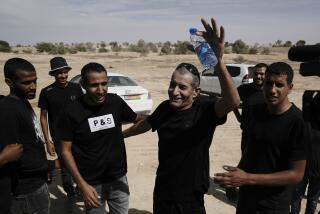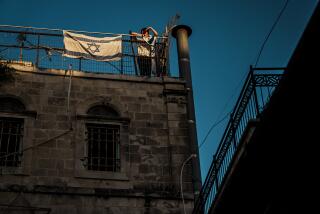2 Capitals in Jerusalem Not Unthinkable
JERUSALEM â In the dusty hillside Jerusalem suburb of Abu Dis, workers are toiling away on an elaborate building that residents believe is destined to house the new parliament of an independent Palestinian state.
It is easy to imagine Palestinian Authority President Yasser Arafat seated in the buildingâs elegant, top-floor office, where a panoramic window opens onto a breathtaking view of the Mount of Olives and, beyond it, the gilded Dome of the Rock, seminal Muslim symbol of Jerusalem.
Abu Dis is one element of an evolving debate on the most formidable obstacle to peace between Israel and the Palestinians: how to share the disputed city of Jerusalem.
With little fanfare and in meetings both here and abroad, officials and academics are reexamining maps, calculating demographics and floating a number of proposals that suggest a new pragmatism and urgency.
Key to the debate is seeing Jerusalem as a city instead of a symbol, divorcing it temporarily from the rhetoric and addressing it as a collection of neighborhoods that can be divvied up.
Both Israelis and Palestinians claim the holy city as their capital, and any compromise will undoubtedly draw a firestorm of protest from both sides, objections that could ultimately spell its death.
And none of the discussions so far have involved the Old City, where sites holy to Judaism, Islam and Christianity are clustered together, because it remains simply too sensitive to address.
Still, the mere fact that serious, if informal, discussions have begun on solutions for Jerusalem and possible concessions by Israel marks a watershed. Ideas are in the air that would have been branded heresy not so long ago.
One that is gaining currency has Israel transferring several Arab neighborhoods in Jerusalem to Palestinian civilian administration. While Israel would retain sovereignty and security control, the Palestinians would be put in charge of municipal services and all aspects of daily government in such Arab neighborhoods as Beit Hanina and Shuafat, which lie on the northern edge of Jerusalem.
With the addition of Abu Dis and other suburbs just outside the city limits, the Palestinians could knit together a quasi capital city. Both Israelis and Palestinians would, in effect, have something they could call Jerusalem.
Leaked by negotiators as a trial balloon, this proposal has yet to take on official life. But it is already generating excitement among proponents--who think that it shows creative realism--and outrage among critics. One senior Israeli government official, Cabinet minister Haim Ramon, dismissed the notion out of hand, branding it a nonstarter, while Jewish settlers have begun organizing demonstrations and a petition drive against it.
Both Arafat and Israeli Prime Minister Ehud Barak will have trouble selling any compromise on Jerusalem to their constituents. Barak especially will face tremendous opposition if he appears open to concessions at the same time that he tries to build support for an unpopular peace treaty with Syria. For many Jews, Jerusalem as the âindivisibleâ capital of Israel is sacrosanct; for many Palestinians, anything less than Jerusalem as capital of an eventual state would be a pittance.
An Alternative Capital for the Palestinians
Abu Dis, however, has long been suggested as an alternative capital for the Palestinians, who lay claim to the eastern part of Jerusalem that was seized from Jordan by Israel in the 1967 Middle East War. Arafat has asked Barak to include Abu Dis and adjacent villages in the next chunk of territory that Israel relinquishes to full Palestinian control.
The village currently is under Israeli-Palestinian administration. An Israeli withdrawal scheduled for this month was delayed, but officials say the transfer of Abu Dis is just a matter of time.
Already home to the Arafat-appointed âgovernorâ for Jerusalem and a contingent of the Palestinian police, Abu Dis is as close to Jerusalem as it is possible to be without venturing inside the city limits.
The city boundary line, in fact, runs through the middle of the five-story, marble-trimmed building under construction there. Officially an âeconomic studies center,â the $4-million, 14,000-square-foot structure has a large domed meeting hall and a bank of offices--perfect for a parliament.
Most important is that view from the top floor. To accept Abu Dis as at least an interim capital, Palestinians would have to see it as a link to Jerusalemâs Old City and the Islamic shrines there--the Dome of the Rock and Al Aqsa mosque, the third-holiest site in Islam. The Old City also contains the Western Wall, the last vestige of the Second Temple and the holiest site in Judaism. Abu Dis is the same distance from the Dome of the Rock, about 1.8 miles, as is the Israeli parliament and government center.
Would Palestinians accept Abu Dis, a village, as a capital?
Musa abu Hillal, a 45-year-old father of three who lives practically in the shadow of the new building, has mixed emotions.
âEver since we are born, we look to Jerusalem as our capital,â said Abu Hillal, seated in a plastic chair in his front yard last week. âHow can this be a replacement? But weâve been hearing it a long time, that Abu Dis will be our capital. What can we do?â
Israel May Cede Some Neighborhoods
Beyond Abu Dis, Israeli negotiators have informally signaled to Palestinian officials that they might be willing to cede day-to-day control of neighborhoods like Beit Hanina and Shuafat.
Granting Arafatâs Palestinian Authority jurisdiction over these neighborhoods--and eventually others in East Jerusalem--would give tacit recognition to the reality that the residents already look to the Palestinian leadership. In much of East Jerusalem, for example, the Palestinian Authority runs the school curricula, religious courts and some police functions, often in contravention of various interim treaties.
Palestinians are relatively receptive to the Beit Hanina-Shuafat idea, although none will say that it would be a replacement for control over the Old City. Where Abu Dis has the problem of being hemmed in by Jewish areas that block its expansion, the northern neighborhoods have room to grow. Although they donât have a view of the Dome of the Rock, they could hook up easily with Ramallah, a principal Palestinian city that is already the center of much Palestinian government and commercial life.
And proponents of the idea point to several pragmatic advantages for Israel. The neighborhoods in question feel little affinity with the Jewish state, and Israelis feel no affinity with them. Losing Beit Hanina and Shuafat and the more than 40,000 Arabs who live in them would also give Israelâs Jerusalem a big demographic boost by increasing the cityâs Jewish majority.
âThe argument is that these are parts of Jerusalem that have nothing to do with Israel and Israelis--it is not in our interest to keep them,â said Ron Pundak, an Israeli academic and veteran peace negotiator who is involved in some of the ongoing discussions.
Jewish residents in the vicinity are nervous. Beit Hanina and Shuafat are bordered on the east by the Jewish neighborhood of Pisgat Zeev, where residents last week held an emergency meeting to plan their fight against any enhanced Palestinian control. They fear becoming an enclave.
âThese are our homes, our lives, and if we donât wake up now, tomorrow we will find Palestinian policemen near our homes, our cars, our children and our schools,â Eli Ben Hamo, a Pisgat Zeev community leader, told the small crowd that gathered. It was a mostly secular, politically moderate group, not the kind of militants often associated with settlement battles.
âWe must not remain silent,â Ben Hamo continued.
Benny Kashriel, chairman of a powerful organization of settlers, the Yesha Council, said the group will launch a petition drive this week against relinquishing any of Jerusalemâs neighborhoods or suburbs, Abu Dis included, to Palestinian control.
Barak âis ready to divide Jerusalem,â Kashriel charged.
But Ramon, the Israeli Cabinet minister, indicated that the neighborhood-by-neighborhood approach would not work unless the Palestinians first give up their claims to sovereignty over the Old City, which is highly unlikely.
âThere are many interesting ideas. So what? None of it solves the whole problem,â he said in an interview in his Tel Aviv office. âWe are listening. We are talking. But at the end of the day, we [the government] have to make the political decisions. I cannot see how, in the near future, we can reach an agreement over Jerusalem.â
Peace Talks Enter Make-or-Break Phase
Ramon said he believes Jerusalem will have to be separated from an overall peace settlement. Israelis and Palestinians will have to agree to disagree on Jerusalem, he said, and put off serious discussions for months or years.
Yet what participants call a âgermination processâ involving the city continues, much like the brainstorming leading up to the landmark Oslo accords that launched Israelis and Palestinians on an irreversible pursuit of peace.
The participants in some of these discussions say thatâs in part because both peoples have matured and, under a new Israeli government, negotiations have entered what is supposed to be a final, make-or-break year.
âJerusalem used to be a taboo,â said Faisal Husseini, the leading Palestinian official in Jerusalem. âThings are changing. We are starting to talk about realities and details, not just the spiritual meaning of Jerusalem. There is a reality, and people are starting to think about how it will work.â
More to Read
Sign up for Essential California
The most important California stories and recommendations in your inbox every morning.
You may occasionally receive promotional content from the Los Angeles Times.











